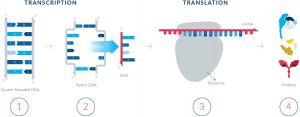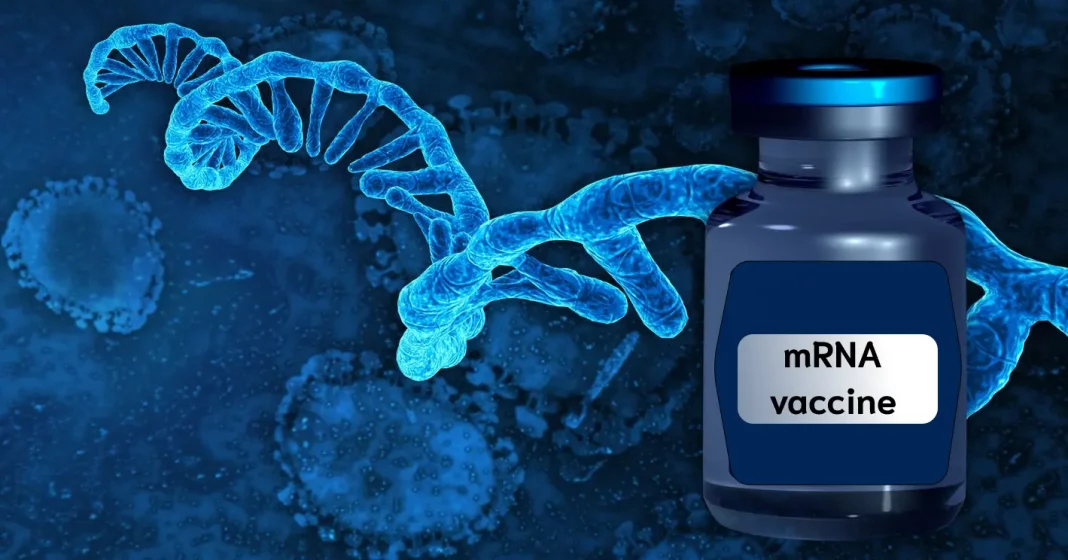Messenger Ribonucleic Acid
An mRNA vaccine is a type of vaccine that uses a copy of a molecule called messenger RNA (mRNA) to produce an immune response. The vaccine delivers molecules of antigen-encoding mRNA into immune cells, which use the designed mRNA as a blueprint to build foreign protein that would normally be produced by a pathogen (such as a virus) or by a cancer cell. These protein molecules stimulate an adaptive immune response that teaches the body to identify and destroy the corresponding pathogen or cancer cells. The mRNA is delivered by a co-formulation of the RNA encapsulated in lipid nanoparticles that protect the RNA strands and help their absorption into the cells.
Reactogenicity, the tendency of a vaccine to produce adverse reactions, is similar to that of conventional non-RNA vaccines. People susceptible to an autoimmune response may have an adverse reaction to messenger RNA vaccines. The advantages of mRNA vaccines over traditional vaccines are ease of design, speed and lower cost of production, the induction of both cellular and humoral immunity, and lack of interaction with the genomic DNA. While some messenger RNA vaccines, such as the Pfizer–BioNTech COVID-19 vaccine, have the disadvantage of requiring ultracold storage before distribution, other mRNA vaccines, such as the Moderna, CureVac, and Walvax COVID-19 vaccines, do not have such requirements.
Source: Wikipedia
What does mRNA do?
mRNA produces instructions to make proteins that may treat or prevent disease. mRNA medicines aren’t small molecules, like traditional pharmaceuticals. And they aren’t traditional biologics (recombinant proteins and monoclonal antibodies) – which were the genesis of the biotech industry. Instead, mRNA medicines are sets of instructions. And these instructions direct cells in the body to make proteins to prevent or fight disease.
It’s actually basic human biology
DNA (deoxyribonucleic acid) is a double-stranded molecule that stores the genetic instructions your body’s cells need to make proteins. Proteins, on the other hand, are the ‘workhorses’ of the body. Nearly every function in the human body – both normal and disease-related – is carried out by one or many proteins.
mRNA is just as critical as DNA
Without mRNA, your genetic code would never get used by your body. Proteins would never get made. And your body wouldn’t – actually couldn’t – perform its functions. Messenger ribonucleic acid, or mRNA for short, plays a vital role in human biology, specifically in a process known as protein synthesis. mRNA is a single-stranded molecule that carries genetic code from DNA in a cell’s nucleus to ribosomes, the cell’s protein-making machinery.
mRNA’s role in protein synthesis

- Through a process known as transcription, an RNA copy of a DNA sequence for creating a given protein is made.
- This copy – mRNA – travels from the nucleus of the cell to the part of the cell known as the cytoplasm, which houses ribosomes. Ribosomes are complex machinery in the cells that are responsible for making proteins.
- Then, through another process known as translation, ribosomes ‘read’ the mRNA, and follow the instructions, creating the protein step by step.
- The cell then expresses the protein and it, in turn, carries out its designated function in the cell or the body.
Source: MODERNA
Mechanism
An illustration of the mechanism of action of a messenger RNA vaccine
The goal of a vaccine is to stimulate the adaptive immune system to create antibodies that precisely target that particular pathogen. The markers on the pathogen that the antibodies target are called antigens.
Traditional vaccines stimulate an antibody response by injecting either antigens, an attenuated (weakened) virus, an inactivated (dead) virus, or a recombinant antigen-encoding viral vector (harmless carrier virus with an antigen transgene) into the body. These antigens and viruses are prepared and grown outside the body.
In contrast, mRNA vaccines introduce a short-lived synthetically created fragment of the RNA sequence of a virus into the individual being vaccinated. These mRNA fragments are taken up by dendritic cells through phagocytosis. The dendritic cells use their internal machinery (ribosomes) to read the mRNA and produce the viral antigens that the mRNA encodes. The body degrades the mRNA fragments within a few days of introduction. Although non-immune cells can potentially also absorb vaccine mRNA, produce antigens, and display the antigens on their surfaces, dendritic cells absorb the mRNA globules much more readily. The mRNA fragments are translated in the cytoplasm and do not affect the body’s genomic DNA, located separately in the cell nucleus.
Once the viral antigens are produced by the host cell, the normal adaptive immune system processes are followed. Antigens are broken down by proteasomes. Class I and class II MHC molecules then attach to the antigen and transport it to the cellular membrane, “activating” the dendritic cell. Once activated, dendritic cells migrate to lymph nodes, where they present the antigen to T cells and B cells. This triggers the production of antibodies specifically targeted to the antigen, ultimately resulting in immunity.
Source: Wikipedia
mRNA vaccines: Latest posts
- Moderna to build a new vaccine plant in the UK
- Moderna invests 500 million euros in Spain to boost vaccine production
- BioNTech begins construction of mRNA vaccine plant in Rwanda soon
- Evonik invests $220 million to build mRNA lipid production facility in the U.S.
- BioNTech plans to advance new formulations for mRNA vaccines in new research collaboration



OF NATURAL PRODUCTS AND EXTRACTS


